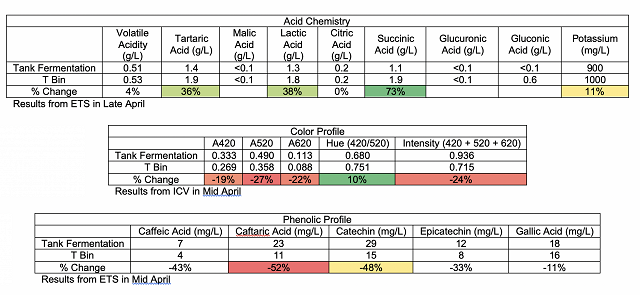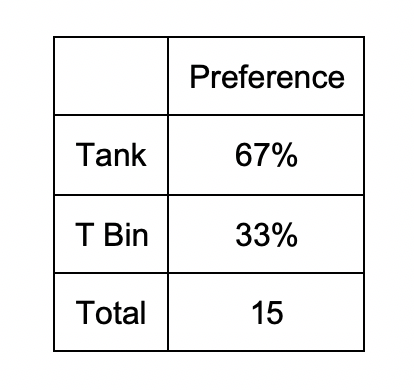Fermenting Merlot in T Bins vs Tanks (2017)
Kirsty Harmon
Blenheim Vineyards
Summary and Introduction
Fermenting in T bins is a common practice in Virginia but may impact wine quality in ways different from fermenting in stainless steel tanks. Thus, investigating the use of these vessels is important for the Virginia wine industry. This study compares fermenting Merlot grapes in T Bins or in Stainless Steel Tanks. Merlot grapes were harvested from the same block and chilled overnight in a refrigerated truck. Grapes were then destemmed but not crushed into a 0.75 ton T Bin as well as a 3 ton stainless steel tank. Fermentations were punched down twice daily throughout fermentation and pressed off after 19 total days. Wine was settled in tank after pressing for 5 days before barreling. All other treatments between wines were identical. The area:height ratio of the tank and the T Bin are approximately 1.340m2/m and 1.355m2/m, respectively. Thus, differences seen are likely not due to dimensions. The T Bin fermentation reached higher fermentation temperatures and exhibited a slightly faster fermentation. The T Bin fermentation resulted in decreased alcohol and increased TA. The T bin had higher tartaric acid, lactic acid, and succinic acid. Color intensity and many phenolic parameters were decreased in the T Bin wine as well. For the triangle test, of 27 people who answered, 15 people chose the correct wine (56%), suggesting a statistically significant difference between wines (p<0.01). These wines were voted to have an average degree difference of 4.6 (out of 10), suggesting that the wines were moderately different. In general, people who answered correctly preferred the tank fermentation the most. For the descriptive analysis, there were no strong trends for the descriptors used in this study. There was a slight tendency for the T Bin wine to have higher Fruit Intensity and Herbaceous/Green character, and lower Bitterness, Astringency, and perhaps lower Body. Judges remarked that there may have been a strange aroma in the T Bin wine, ranging from sulfuric to volatile acidity to ethyl acetate. This may have impacted the perception of Fruit Intensity in this wine. From the chemistry, it is not clear what may be causing this aroma. These differences are hypothesized to be caused by differences in temperature and oxygen exposure between treatments, although not enough data is available to confirm or deny this. In the future this study should be repeated multiple times to gain more information and should be analyzed in more detail.
Results and Discussion
The area:height ratio of the tank and the T Bin are approximately 1.340m2/m and 1.355m2/m, respectively. Thus, differences seen are likely not due to dimensions. Cap height was not measured, but it is assumed that it was similar between treatments given similar dimensions. The T Bin fermentation reached higher fermentation temperatures and exhibited a slightly faster fermentation. The T Bin fermentation resulted in decreased alcohol and increased TA. The T bin had higher tartaric acid, lactic acid, and succinic acid. Color intensity and many phenolic parameters were decreased in the T Bin wine as well.




For the triangle test, of 27 people who answered, 15 people chose the correct wine (56%), suggesting a statistically significant difference between wines (p<0.01). These wines were voted to have an average degree difference of 4.6 (out of 10), suggesting that the wines were moderately different. In general, people who answered correctly preferred the tank fermentation the most. For the descriptive analysis, there were no strong trends for the descriptors used in this study. There was a slight tendency for the T Bin wine to have higher Fruit Intensity and Herbaceous/Green character, and lower Bitterness, Astringency, and perhaps lower Body. Judges remarked that there may have been a strange aroma in the T Bin wine, ranging from sulfuric to volatile acidity to ethyl acetate. This may have impacted the perception of Fruit Intensity in this wine. From the chemistry, it is not clear what may be causing this aroma.


It seems likely that the different fermentation temperatures were a cause for the differences seen between treatments, but not enough information is available to fully determine in what ways temperature affected these parameters. Punchdowns were easier to perform on the tanks than on the T bins, and as a result the T bin cap temperature may have been higher, leading to higher levels of extraction. Cap temperature, however, was not measured. Although T bins were wrapped in plastic to minimize oxygen exposure, the T bin treatment would still be a more aerobic environment which could lead do microbial differences, further exacerbated by the difficulty of punchdowns for this particular fermentation. These differences, along with differences in temperature, may have resulted in the chemical and sensory differences seen. However, in the future this study should be repeated multiple times to get more information and should be analyzed in more detail.
Methods
Merlot grapes were harvested from the same block and chilled overnight in a refrigerated truck. Grapes were then destemmed but not crushed (rollers in outermost position, Zickler destemmer) into a 0.75 ton T Bin as well as a 3 ton stainless steel tank. The dimensions of the stainless steel tank were 1.6m diameter with a variable capacity height of up to 1.5 m. The dimensions of the T Bin were 40Wx48Lx36H inches. These resulted in an area:height ratio of 1.340m2/m and 1.355m2/m, respectively, or 52.76in2/in and 53.33in2/in, respectively. Fermentations were punched down twice daily throughout fermentation and pressed off after 19 total days. The T bin treatment was covered with plastic wrap during its use. Wine was settled in tank after pressing for 5 days before barreling. Sulfur dioxide was added at a rate of 75 ppm after malolactic fermentation was complete (tested by enzymatic assay).
This project was tasted on May 30. For the triangle test, descriptive analysis, and preference analysis, anybody who did not answer the form were removed from consideration for both triangle, degree of difference, and preference. Additionally, anybody who answered the triangle test incorrectly were removed from consideration for degree of difference and preference. Additionally, any data points for preference which did not make sense (such as a person ranking a wine and its replicate at most and least preferred, when they correctly guessed the odd wine) were removed.
In order to balance the data set to perform statistical analysis for descriptive analysis on the May 30 tasting, any judge who had not fully completed the descriptive analysis ratings were removed. In order to then make the number of judges between groups equivalent, two judges from group 1 and one from group 3 were transferred to group 2. This resulted in a final data set of 3 groups, each with 8 judges (considered as replications within groups, and groups were considered as assessors). Data was analyzed using Panel Check V1.4.2. Because this is not a truly statistical set-up, any results which are found to be statistically significant (p<0.05) will be denoted as a “strong trend” or a “strong tendency,” as opposed to general trends or tendencies. The statistical significance here will ignore any other significant effects or interactions which may confound the results (such as a statistically significant interaction of Judge x Wine confounding a significant result from Wine alone). The descriptors used in this study were Fruit Intensity, Herbaceous/Green, Overall Aromatic Intensity, Bitterness, Astringency, and Body.
